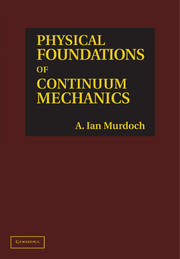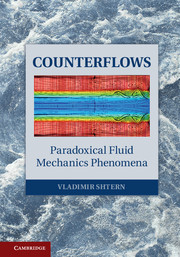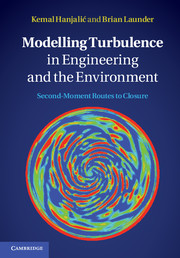Refine search
Actions for selected content:
8126 results in Fluid dynamics and solid mechanics
8 - Rapidly-Rotating Turbulence: An Experimental Perspective
-
-
- Book:
- Ten Chapters in Turbulence
- Published online:
- 05 February 2013
- Print publication:
- 06 December 2012, pp 318-350
-
- Chapter
- Export citation
3 - Passive Scalar Transport in Turbulence: A Computational Perspective
-
-
- Book:
- Ten Chapters in Turbulence
- Published online:
- 05 February 2013
- Print publication:
- 06 December 2012, pp 87-131
-
- Chapter
- Export citation
Preface
-
- Book:
- Ten Chapters in Turbulence
- Published online:
- 05 February 2013
- Print publication:
- 06 December 2012, pp ix-x
-
- Chapter
- Export citation
Contents
-
- Book:
- Ten Chapters in Turbulence
- Published online:
- 05 February 2013
- Print publication:
- 06 December 2012, pp v-viii
-
- Chapter
- Export citation
10 - How Similar is Quantum Turbulence to Classical Turbulence?
-
-
- Book:
- Ten Chapters in Turbulence
- Published online:
- 05 February 2013
- Print publication:
- 06 December 2012, pp 405-437
-
- Chapter
- Export citation
NUMERICAL SIMULATION OF ATHEROSCLEROTIC PLAQUE GROWTH USING TWO-WAY FLUID–STRUCTURAL INTERACTION
- Part of
-
- Journal:
- The ANZIAM Journal / Volume 53 / Issue 4 / April 2012
- Published online by Cambridge University Press:
- 15 November 2012, pp. 278-291
-
- Article
-
- You have access
- Export citation
ANZ VOLUME 53 ISSUE 3 COVER AND BACK MATTER
-
- Journal:
- The ANZIAM Journal / Volume 53 / Issue 3 / January 2012
- Published online by Cambridge University Press:
- 12 November 2012, pp. b1-b6
-
- Article
-
- You have access
- Export citation
ANZ VOLUME 53 ISSUE 3 COVER AND FRONT MATTER
-
- Journal:
- The ANZIAM Journal / Volume 53 / Issue 3 / January 2012
- Published online by Cambridge University Press:
- 12 November 2012, pp. f1-f2
-
- Article
-
- You have access
- Export citation
INVISCID AND VISCOUS MODELS OF AXISYMMETRIC FLUID JETS OR PLUMES
- Part of
-
- Journal:
- The ANZIAM Journal / Volume 53 / Issue 3 / January 2012
- Published online by Cambridge University Press:
- 12 November 2012, pp. 228-250
-
- Article
-
- You have access
- Export citation

Physical Foundations of Continuum Mechanics
-
- Published online:
- 05 November 2012
- Print publication:
- 22 October 2012

Counterflows
- Paradoxical Fluid Mechanics Phenomena
-
- Published online:
- 05 November 2012
- Print publication:
- 15 October 2012

Mathematical Aspects of Fluid Mechanics
-
- Published online:
- 05 November 2012
- Print publication:
- 18 October 2012

Modelling Turbulence in Engineering and the Environment
- Second-Moment Routes to Closure
-
- Published online:
- 05 November 2012
- Print publication:
- 20 October 2011
13 - Comments on Non-Local Balance Relations
-
- Book:
- Physical Foundations of Continuum Mechanics
- Published online:
- 05 November 2012
- Print publication:
- 22 October 2012, pp 255-262
-
- Chapter
- Export citation
Index
-
- Book:
- Physical Foundations of Continuum Mechanics
- Published online:
- 05 November 2012
- Print publication:
- 22 October 2012, pp 413-423
-
- Chapter
- Export citation
Preface
-
- Book:
- Physical Foundations of Continuum Mechanics
- Published online:
- 05 November 2012
- Print publication:
- 22 October 2012, pp xiii-xiv
-
- Chapter
- Export citation
6 - Balance of Energy
-
- Book:
- Physical Foundations of Continuum Mechanics
- Published online:
- 05 November 2012
- Print publication:
- 22 October 2012, pp 102-114
-
- Chapter
- Export citation
Contents
-
- Book:
- Physical Foundations of Continuum Mechanics
- Published online:
- 05 November 2012
- Print publication:
- 22 October 2012, pp vii-xii
-
- Chapter
- Export citation
Appendix B - Calculus in Euclidean Point Space ℰ
-
- Book:
- Physical Foundations of Continuum Mechanics
- Published online:
- 05 November 2012
- Print publication:
- 22 October 2012, pp 356-406
-
- Chapter
- Export citation
10 - Fluid Flow through Porous Media
-
- Book:
- Physical Foundations of Continuum Mechanics
- Published online:
- 05 November 2012
- Print publication:
- 22 October 2012, pp 188-208
-
- Chapter
- Export citation
